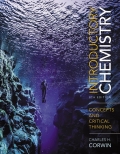
Concept explainers
(a)
Interpretation:
Whether the property of shiny solid is possessed by a metal or nonmetal is to be stated.
Concept introduction:
An element is the basic unit of a substance that cannot be broken down into any smaller units. An element can be classified as metal, nonmetal or metalloid. A metalloid has the properties in between the metals and nonmetals. A metal possess certain characteristic properties like malleability, ductility, shiny appearance and so on. On the other hand, a nonmetal can be characterized by its peculiar properties like brittleness, low density, low melting point etc.
(b)
Interpretation:
Whether the property of brittle solid is possessed by a metal or nonmetal is to be stated.
Concept introduction:
An element is the basic unit of a substance that cannot be broken down into any smaller units. An element can be classified as metal, nonmetal or metalloid. A metalloid has the properties in between the metals and nonmetals. A metal possess certain characteristic properties like malleability, ductility, shiny appearance and so on. On the other hand, a nonmetal can be characterized by its peculiar properties like brittleness, low density, low melting point etc.
(c)
Interpretation:
Whether the property of low density is possessed by a metal or nonmetal is to be stated.
Concept introduction:
An element is the basic unit of a substance that cannot be broken down into any smaller units. An element can be classified as metal, nonmetal or metalloid. A metalloid has the properties in between the metals and nonmetals. A metal possess certain characteristic properties like malleability, ductility, shiny appearance and so on. On the other hand, a nonmetal can be characterized by its peculiar properties like brittleness, low density, low melting point etc.
(d)
Interpretation:
Whether the property of alloy formation is possessed by a metal or nonmetal is to be stated.
Concept introduction:
An element is the basic unit of a substance that cannot be broken down into any smaller units. An element can be classified as metal, nonmetal or metalloid. A metalloid has the properties in between the metals and nonmetals. A metal possess certain characteristic properties like malleability, ductility, shiny appearance and so on. On the other hand, a nonmetal can be characterized by its peculiar properties like brittleness, low density, low melting point etc.
Want to see the full answer?
Check out a sample textbook solution
Chapter 3 Solutions
EBK INTRODUCTORY CHEMISTRY
- Provide the formula for each of the following binary ionic compounds. (a) copper(I) oxide (b) iron(II) nitride (c) mercury(II) chloride (d) lead(IV) sulfidearrow_forwardDistinguish between the terms in each of the following pairs, using specific examples.. (b) physical and chemical properties (c) atom and ion d) acid and base e) ionic and molecular compoundarrow_forwardWhich of the following elements is not one of the 10 most abundant in Earth’s crust, oceans, and atmosphere? (Sec. 3.3) (a) aluminum (b) iron (c) oxygen (d) silicon (e) silverarrow_forward
- Choose the box color(s) in the periodic table in the figure that match(es) each of the following .(a) Four elements that are nonmetals (b) Two elements that are metals (c) Three elements that are gases at room temperature (d) Three elements that are solid at room temperature (e) One pair of elements likely to form a covalent compound (f) Another pair of elements likely to form a covalent compound(g) One pair of elements likely to form an ionic compound withformula MX(h) Another pair of elements likely to form an ionic compound with formula MX(i) Two elements likely to form an ionic compound with for-mula M₂X (j) Two elements likely to form an ionic compound with formula MX₂ (k) An element that forms no compounds (l) A pair of elements whose compounds exhibit the law of mul-tiple proportions(m) Two elements that are building blocks in biomolecules(n) Two elements that are macronutrients in organismsarrow_forwardis paint a compound or elementarrow_forwardWhich of the following generally occurs in nature as an atomic element and not a molecular element? (a)Iodine (b) Hydrogen (c) Argon (d)Fluorine (e) Nitrogenarrow_forward
- Malachite is an are of:(a) Iron(b) Copper (c) Mercury(d) Zincarrow_forward(a) copper(II) nitrate (b) sulfur QUESTION 2: What does the following picture show? S. OUESTION 2arrow_forwardchoose two .The coulomb force is the attraction or repulsion of protons and electrons because of their electric charge so (a) Proton repulse other protons (b)electrons are attracted to protons (c) Electrons repulse other electronsarrow_forward
- An element reacts with oxygen to give a compound with a high melting point. This compound is also soluble in water. The element is likely to be(a) Calcium(b) Carbon(c) Silicon(d) Ironarrow_forwardWhich of the following is best characterized as a heterogeneous mixture? Group of answer choices (a) Air (b) Sandy Dirt (c) An aqueous solution of NaCl (d) Electrum (an alloy of gold and silver) (e) Clear Diamondarrow_forwardWhich of these are a mixture, air, water, hydrogen chloride, or carban dioxidearrow_forward
 World of Chemistry, 3rd editionChemistryISBN:9781133109655Author:Steven S. Zumdahl, Susan L. Zumdahl, Donald J. DeCostePublisher:Brooks / Cole / Cengage Learning
World of Chemistry, 3rd editionChemistryISBN:9781133109655Author:Steven S. Zumdahl, Susan L. Zumdahl, Donald J. DeCostePublisher:Brooks / Cole / Cengage Learning Introductory Chemistry: A FoundationChemistryISBN:9781337399425Author:Steven S. Zumdahl, Donald J. DeCostePublisher:Cengage Learning
Introductory Chemistry: A FoundationChemistryISBN:9781337399425Author:Steven S. Zumdahl, Donald J. DeCostePublisher:Cengage Learning Living By Chemistry: First Edition TextbookChemistryISBN:9781559539418Author:Angelica StacyPublisher:MAC HIGHER
Living By Chemistry: First Edition TextbookChemistryISBN:9781559539418Author:Angelica StacyPublisher:MAC HIGHER World of ChemistryChemistryISBN:9780618562763Author:Steven S. ZumdahlPublisher:Houghton Mifflin College DivChemistry: Matter and ChangeChemistryISBN:9780078746376Author:Dinah Zike, Laurel Dingrando, Nicholas Hainen, Cheryl WistromPublisher:Glencoe/McGraw-Hill School Pub Co
World of ChemistryChemistryISBN:9780618562763Author:Steven S. ZumdahlPublisher:Houghton Mifflin College DivChemistry: Matter and ChangeChemistryISBN:9780078746376Author:Dinah Zike, Laurel Dingrando, Nicholas Hainen, Cheryl WistromPublisher:Glencoe/McGraw-Hill School Pub Co




